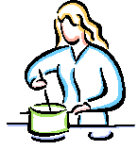 Brewing Guide to Cafetieres / French Press
Brewing Guide to Cafetieres / French Press
From: http://www.handloom.co.uk/learn/brewing-guide-to-cafetieres.html
Cafetiere, or french press, coffee makers are a great way to make coffee as the brew they produce is rich and full bodied. They are simple to use and are fairly easy to clean afterwards.
Many coffee lovers swear that cafetieres are the best coffee makers, as they let the coffee do the talking. All the delicate flavours in the oils are preserved, allowing the individual character of the coffee to speak.
Some people are put off coffee made in a cafetiere as it contains sediment. However, some sediment is desirable as it adds texture and mouthfeel to the cup.
Standard Method
1. Boil Water: Fill the kettle with enough freshly drawn water to fill the cafetiere twice over and bring to the boil.
Tip - If you don't like the taste of your tap water, it's worth investing in a water filter such as a Britta jug. This is also important if you live in a hard water area, as hard water contains alkalines which can neutralise the acids that give coffee its bright and subtle flavours.
2. Grind and Weigh Coffee: If you're grinding your own coffee, grind it whilst waiting for the kettle to boil. The coffee should be ground very coarse (like sea salt) with the largest particles approximately 3-4mm in length. If you buy your coffee pre-ground and it's not very coarse, reduce the infusion time (see Step 7).
You will need 6g of ground coffee for every 100ml of water. So if you're planning to make 250ml of coffee, you'll need 15g of grounds; for 1ltr you'll need 60g.
Tip - You should measure exactly how much water your cafetiere can hold. Don't rely on the capacity stated by the manufacturer, as these are only approximations. If you don't have a set of digital scales, as a general rule of thumb: a tablespoon holds approximately 5g of coffee and a coffee scoop (which is often supplied with a cafetiere) holds 7g.
3. Pre-heat Cafetiere: Once the kettle has boiled, fill the cafetiere with boiling water and insert plunger.
Tip - It's important to pre-heat your cafetiere before brewing. A cold cafetiere will lose up to 10°C within the first minute of brewing, which will result in an uneven extraction.
4. Add Ground Coffee: After pre-heating your cafetiere for 1 minute, discard the water and give it a quick wipe. Now add the ground coffee.
5. Add Water: The remaining water in your kettle should now have cooled sufficiently to brew coffee. With the spout of the kettle positioned just above the cafetiere, slowly pour water into it. Fill it to 1cm below the bottom of the spout and start the timer.
Tip - Never use boiling water to brew coffee as it will destroy the delicate aromatic flavours and heighten bitter and sour ones. Instead you should brew coffee using water between 90-95°C. By pouring from a low height you're reducing the amount of agitation caused when the water hits the coffee grounds. It's difficult to control this form of agitation, so it's far better to minimise its affect and rely on more consistent methods of agitation such as stirring. Whilst elaborate pours from great heights may look spectacular, they impact on the grounds differently every time, giving inconsistent results to your brew.
6. Stir: Give the coffee solution two gentle stirs to insure the grounds are evenly wet. Now replace the plunger, bringing it to rest just above the solution.
7. Infuse for 4 Minutes: Leave the coffee solution to infuse for 4 minutes. Then, using little more than the weight of your hand, press the plunger down.
8. Serve Immediately: Serve the coffee immediately. Don't leave it in the cafetiere as it will continue to slowly extract.
If you're not going to drink the coffee straight away, transfer the solution from the cafetiere into an insulated flask.

